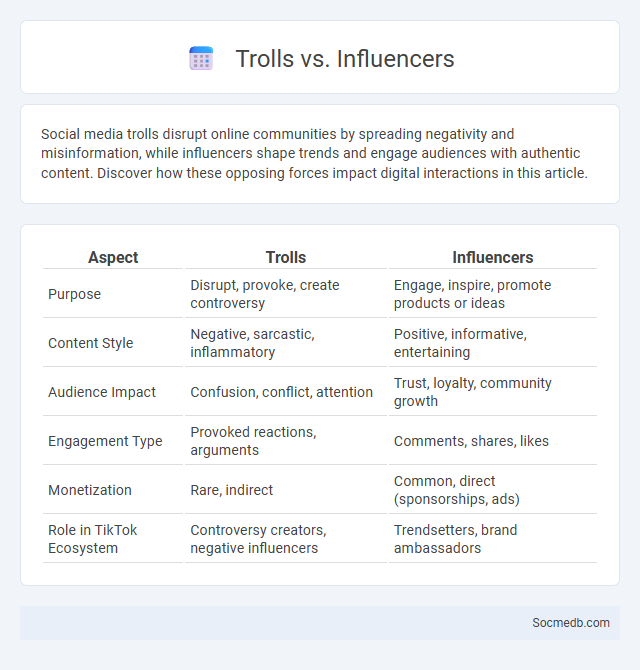
Photo illustration: Trolls vs Influencers
Social media trolls disrupt online communities by spreading negativity and misinformation, while influencers shape trends and engage audiences with authentic content. Discover how these opposing forces impact digital interactions in this article.
Table of Comparison
| Aspect | Trolls | Influencers |
|---|---|---|
| Purpose | Disrupt, provoke, create controversy | Engage, inspire, promote products or ideas |
| Content Style | Negative, sarcastic, inflammatory | Positive, informative, entertaining |
| Audience Impact | Confusion, conflict, attention | Trust, loyalty, community growth |
| Engagement Type | Provoked reactions, arguments | Comments, shares, likes |
| Monetization | Rare, indirect | Common, direct (sponsorships, ads) |
| Role in TikTok Ecosystem | Controversy creators, negative influencers | Trendsetters, brand ambassadors |
Understanding the Rise of Trolls and Influencers
The rise of trolls and influencers on social media reflects shifting dynamics in online engagement and content creation. Trolls often exploit anonymity to spread negativity and provoke emotional reactions, while influencers use personal branding to build trust and monetize their platforms. Understanding these roles helps you navigate social media more effectively, recognizing potential risks and opportunities in digital interactions.
Defining Trolls: Motivations and Impact
Trolls on social media are individuals who deliberately provoke or disrupt online discussions to elicit emotional responses or create conflict. Their motivations often include seeking attention, spreading misinformation, or influencing opinions for personal or political gain. Understanding these behaviors helps you navigate online spaces more safely and recognize the impact trolls have on digital communities' trust and engagement.
Influencers Unveiled: Power and Responsibility
Influencers wield significant power in shaping consumer behavior and trends across platforms such as Instagram, TikTok, and YouTube, reaching billions globally. Their responsibility extends beyond promotion to include authentic engagement, ethical content creation, and transparency, essential for maintaining trust and credibility. Brands increasingly prioritize partnerships with influencers who demonstrate accountability and align with social values, amplifying social media's impact on culture and commerce.
The Clash: Trolls vs Influencers Online
Trolls disrupt online communities by spreading negativity and misinformation, while influencers cultivate trust and engagement through authentic content. Your ability to differentiate between toxic behavior and genuine influence can enhance your social media experience. Leveraging influencer insights helps counteract trolls and fosters positive digital interactions.
Strategies Trolls Use Against Influencers
Trolls commonly employ strategies such as coordinated harassment campaigns, spreading false information, and manipulating engagement metrics to undermine influencers' credibility. They exploit platform algorithms by mass-reporting content or using bot accounts to amplify negative messages, causing disruptions in influencers' reach and audience trust. Understanding these tactics is crucial for developing robust moderation tools and resilience training to protect influencers from reputational damage.
Influencers’ Defense Mechanisms Against Trolls
Influencers employ various defense mechanisms against trolls, including content moderation tools, blocking and reporting harmful users, and utilizing mental resilience strategies to maintain their well-being. They often engage in community building to foster positive interactions and dilute negative comments, leveraging algorithmic filters to minimize exposure to abusive language. These tactics are crucial in sustaining their online presence and protecting their mental health amidst increasing cyberbullying incidents.
Viral Moments: When Trolls and Influencers Collide
Viral moments on social media emerge when trolls and influencers collide, creating explosive interactions that capture massive audience attention. These clashes often spark heated debates and trend rapidly across platforms like Twitter, Instagram, and TikTok, amplifying reach and engagement. Your content strategy should anticipate such dynamic intersections to maximize visibility and influence.
The Role of Platforms in Mediating Conflict
Social media platforms play a critical role in mediating conflict by shaping communication dynamics and influencing public perception through algorithm-driven content exposure. Your interactions on platforms like Facebook, Twitter, and Instagram can either escalate tensions or promote understanding, depending on how these networks manage misinformation and foster dialogue. Effective mediation tools and community guidelines help platforms minimize conflicts and support constructive conversations among users.
Community Reactions: Fanbases, Support, and Backlash
Social media platforms amplify community reactions, creating dynamic spaces where fanbases mobilize support through viral campaigns and interactive content. These digital ecosystems foster intense emotional connections, yet also generate significant backlash when controversies arise, often magnifying polarized opinions. Monitoring sentiment and engagement metrics reveals the complex interplay between fan loyalty and public criticism shaping brand reputations online.
Future Trends: The Evolving Battle of Trolls vs Influencers
The future of social media will witness an intensified battle between trolls and influencers, where platforms deploy advanced AI to detect and mitigate harassment while empowering creators to engage authentically. You must stay informed about evolving moderation tools and community guidelines that protect your influence and foster positive interaction. Navigating this dynamic landscape requires strategic content creation and vigilant reputation management to sustain meaningful online presence.
 socmedb.com
socmedb.com